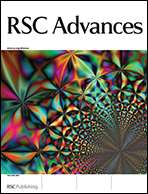A “one step” approach for preparation of an octadecyl–silica hybrid monolithic column via a non-hydrolytic sol–gel (NHSG) method†
Abstract
An octadecyl (C18)–silica hybrid monolithic column was prepared via a “one step”, non-hydrolytic sol–gel (NHSG) method for capillary liquid chromatography (cLC). The effects of various preparation conditions (e.g., polycondensation temperature, alkyl alcohols and crosslinkers) on the morphologies and column efficiencies were studied in detail. Under the optimized conditions, uniform monolithic matrices were obtained, and the minimum plate height for benzene was 11.5 μm, corresponding to ca. 87 000 theoretical plates per meter (N m−1). Baseline-separations of phenolic compounds, benzonic acids and anilines on the prepared C18–silica hybrid monolithic column were achieved by cLC with isocratic elution and showed high efficiency and satisfactory reproducibility. In addition, 16 priority pollutant polycyclic aromatic hydrocarbons (PAHs) and 6 proteins mixture were also well separated on the C18–silica hybrid monolithic column with gradient elution by cLC. Moreover, the prepared hybrid monolithic column was also applied to the analysis of tryptic digests of bovine serum albumin (BSA) by cLC tandem mass spectrometry (cLC-MS/MS), and the results showed that the separation performance was close to that of the C18-particulates packed capillary column, demonstrating its potential in proteome analysis.


 Please wait while we load your content...
Please wait while we load your content...